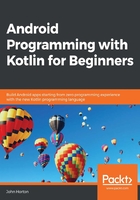
Coding messages to the user and the developer
In the introduction to this chapter and in the previous chapter, we talked a bit about using other people's code, specifically via the classes and their functions of the Android API. We saw that we could do some quite complex things with fairly insignificant amounts of code (such as talking to satellites).
To get us started on coding, we are going to use two different classes from the Android API that allow us to output messages. The first class, Log, allows us to output messages to the logcat window. The second class, Toast, is not a tasty breakfast treat, but it will produce a toast-shaped pop up message for our app's user to see.
Here is the code we need to write to send a message to logcat:
Log.i("info","our message here")
Exactly why this works will become clearer in Chapter 10, Object-Oriented Programming, but for now, we just need to know that whatever we put between the two sets of quote marks will be output to the logcat window. We will see where to put this type of code shortly.
Here is the code we need to write in order to send a message to the user's screen:
Toast.makeText(this, "our message", Toast.LENGTH_SHORT).show()
This is a very convoluted-looking line of code and exactly how it works, again, will not become clear until Chapter 9, Kotlin Functions. The important thing here is that whatever we put between the quote marks will appear in a pop-up message to our users.
Let's put some code (like we have just seen) into our app for real.